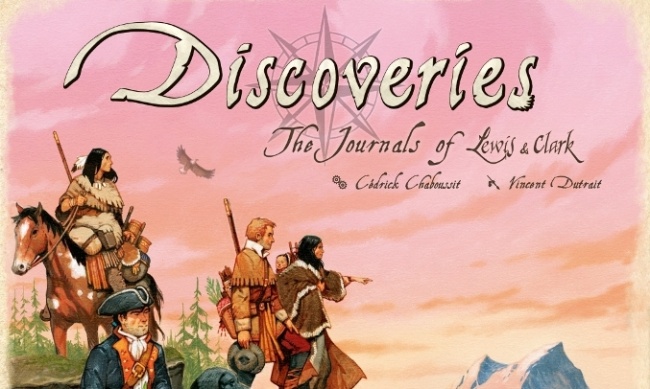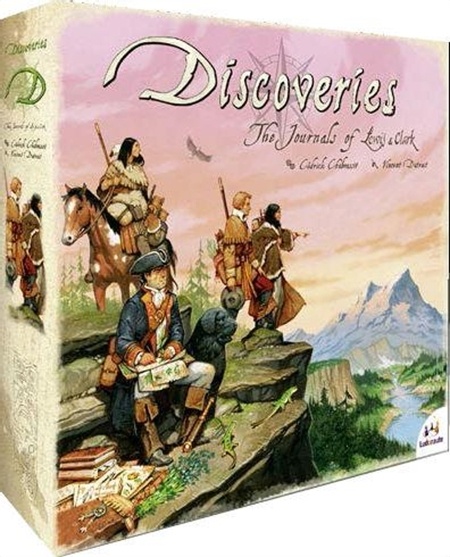Discoveries: The Journals of Lewis & Clark
Publisher: Ludonaute, distributed by Asmodee Editions
Release Date: September 2015
Price: $39.99
Game Designer: Cedrick Chaboussit; artwork by Vincent Dutrait
Format: Board game w/ cards and dice
Game Length: 60+ minutes
Number of players: 2-4
Product #: DIS01
Age Rating: 14+
ICv2 Rating: 4 Stars out of 5
While the suggested game length of 60 minutes may be a little optimistic, even beginning players should be able to play it in 90 minutes or less. The game is well worth the investment of time.
The mechanics of the game and the component design are outstanding. Players are rolling a pool of dice and then spending the results of those dice to score points or to obtain advantages for future turns. The dice have faces representing travel on foot or by horse, for negotiating with tribes and the most important step of all, writing things down so that you get credit for doing them, when the whole expedition is over.
The dice, cards and board are attractive, and all of the cardboard components are sturdy as well as visually attractive. One component’s extra feature, a punch-out, turns out to be less helpful than the designer hoped, but is not a detriment to play.
Negotiating with American Indian tribes [yes, the game uses that term instead of Native American, and uses Census Bureau data to explain why] gives you bonuses in your travels up the Missouri River, and whoever does the best job of that will have several advantages. Still, there are several paths to victory, even if there’s only one path up the river.
Scoring is based on points gained for areas explored, tribes negotiated with, and species discovered. Each of these three contributes to the scoring, and no one dominates the others. If you spend all of your dice on any one of the three areas, rather than a balance, you will probably lose.
Player vs. player action is competitive, but often funny rather than cutthroat, mimicking the very real confusions of authority on the expedition. Thus, another player may commandeer some of the expedition men [or the expedition dog, if you’re a history buff] nominally under your command, but you can take them back at a time which will then embarrass your opponent, partway through an action, many of which take 2-3 turns to complete.
Negotiating with tribes also adds bonus dice to the pool, and careful use of the dice pool is a key to success in the game. Poor dice economy will cause you to waste turns gathering up more dice for re-rolls, in order to complete actions. Learning how and when to retrieve dice from the common pool is the single most important learning curve in the game.
Scoring is simple and straightforward, and players can easily see their goals. It is only achieving them that is sometimes difficult, if you have managed your dice pool badly.
The suggested age range is mainly because the game mechanics for exploration are not quite intuitive. Our group’s first attempt mis-read part of a rule which should have been obvious: You explore cards by following the icons from bottom to top, because you are traveling UP a river, from south to north. Perfectly obvious, and it’s clear in the written rules, but a directional arrow on the card example would have been a helpful reminder. Also, journal entries are always the FINAL part of any action. You do things, and then write them down, again obvious but a bit tricky for beginners.
Overall, a very enjoyable game both for history buffs and casual gamers interested in a historical theme.
--Nick Smith: Librarian Technician, Community Services, for the Pasadena Public Library in California.

ICv2 Stars: 4 (out of 5)
Posted by Nick Smith on September 17, 2015 @ 3:56 am CT
MORE GAMES
New 'Flesh & Blood TCG' Booster Set
July 3, 2025
Legend Story Studios announced Super Slam, a new Flesh & Blood TCG booster set.
New Riff of the Classic Game of War from Chip Theory Games
July 3, 2025
Chip Theory Games will release Fight Five, a new card game, into retail.
MORE REVIEWS
ICv2 Stars: 3.5 (out of 5)
June 20, 2025
Check out the review of Disney Lorcana TCG: Illumineer's Quest - Palace Heist, from Ravensburger.
ICv2 Stars: 3 (out of 5)
May 16, 2025
Here's a review of the board game The Architects of Amytis.








